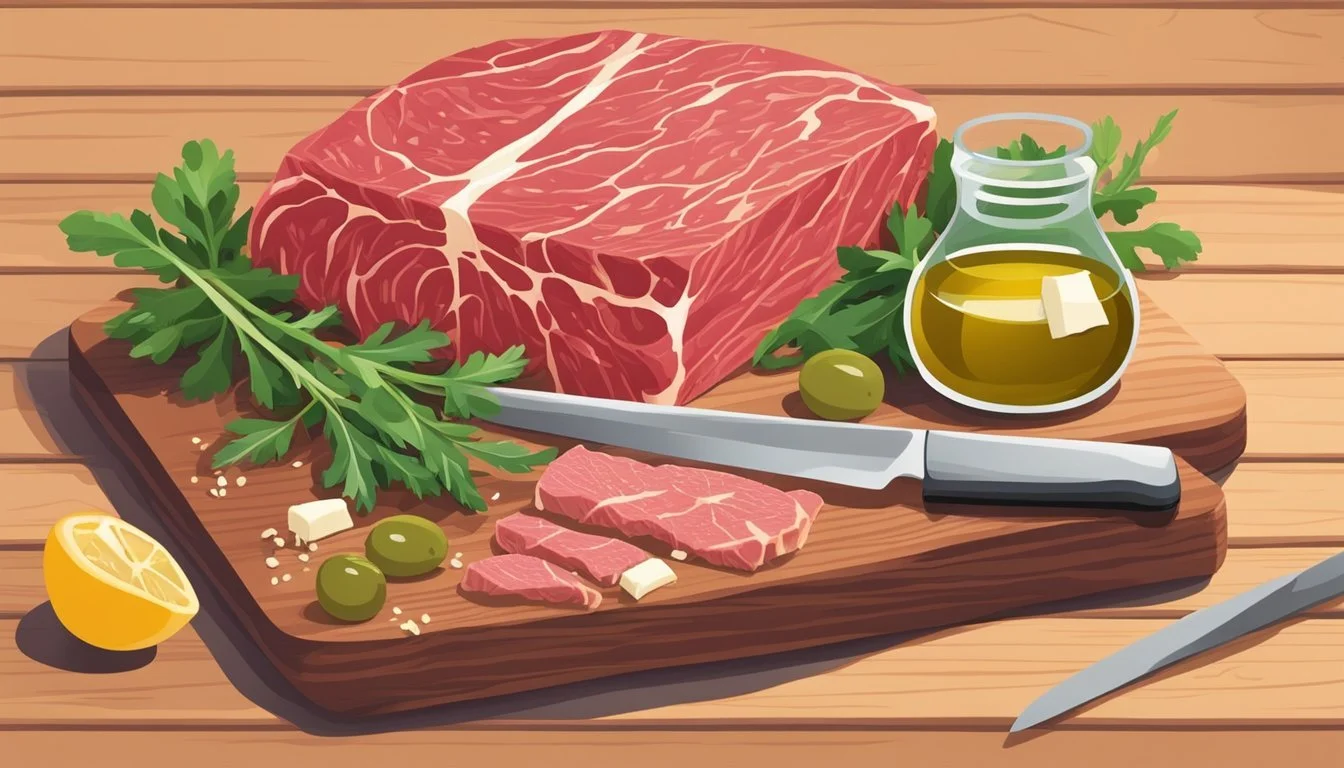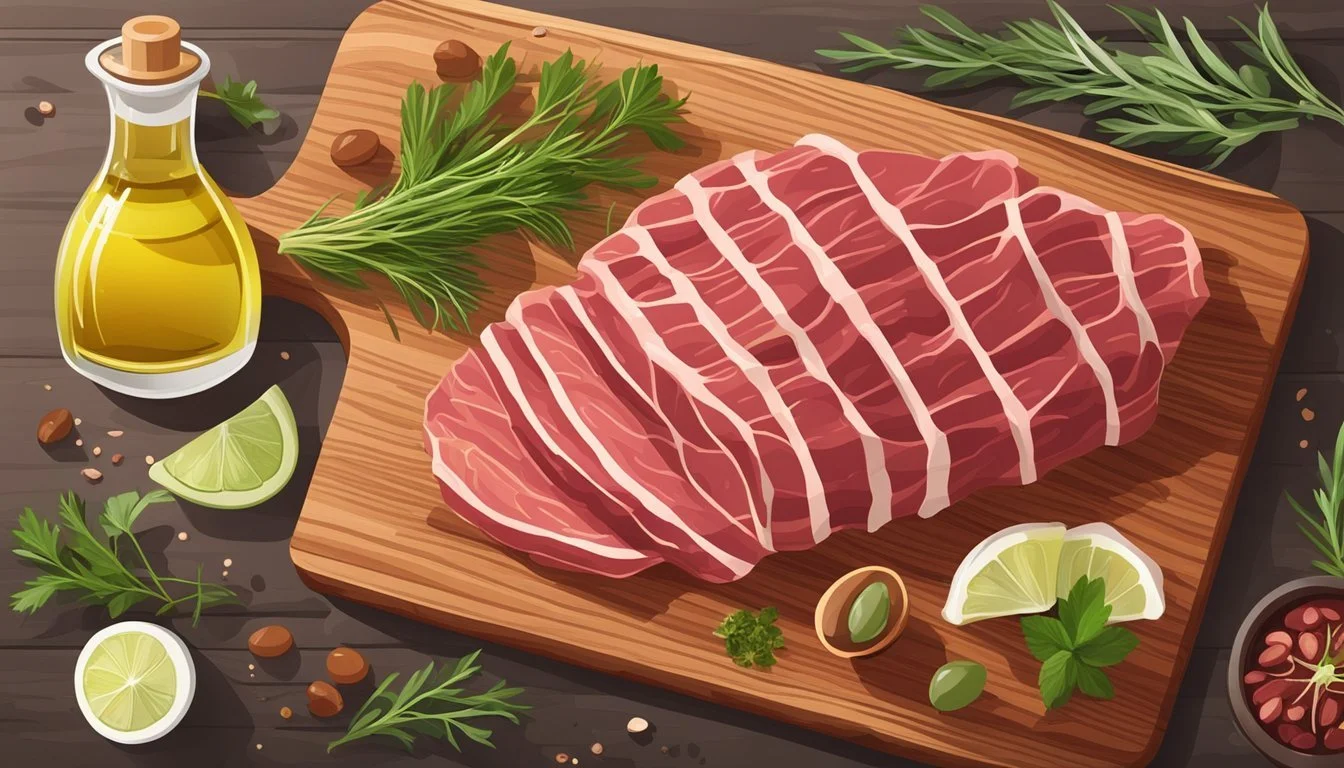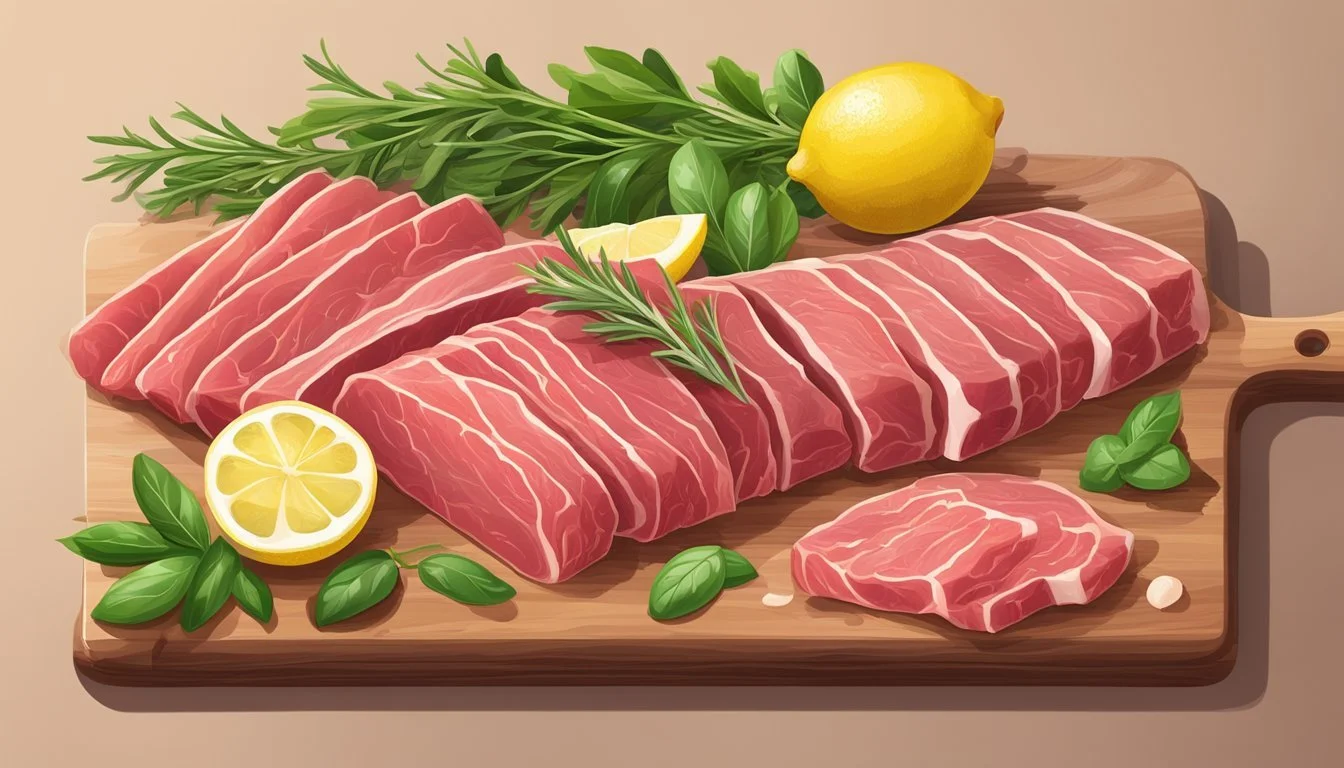How to Prepare a Texas-Style Beef Carpaccio
Your Ultimate Guide
Texas-Style Beef Carpaccio (What wine goes well with beef carpaccio?) is a dish that showcases the robust and hearty flavors favored in Texan cuisine, while still maintaining the elegance and simplicity of the classic Italian appetizer. To prepare this recipe, quality beef is paramount as it’s served raw, thinly sliced, and typically uncooked. The Texas twist involves a seasoned edge that can include a rub or crust of spices, such as freshly cracked mixed peppercorns, to infuse the dish with a bold character.
The preparation method for Beef Carpaccio is surprisingly easy, making it an attainable gourmet experience at home. It begins with freezing the beef slightly to firm it up for delicate slicing. The right cut of beef is typically a lean and tender one, like beef tenderloin (What wine goes well with beef tenderloin?). To execute the dish with a Texan style, one might introduce ingredients like spicy arugula or a zesty sauce to complement the rich beef flavors. Serving it on chilled plates enhances the freshness and integrates a refined touch to this rustic-inspired dish.
The art of crafting Beef Carpaccio requires attention to detail and an appreciation for the quality of the ingredients. It’s an exercise in balance: the thinness of the beef slices, the kick of the seasoning, and the cool crispness of the accompaniments. In Texas, where the culinary scene seamlessly melds ruggedness with sophistication, Beef Carpaccio can be considered a reflection of the state's eclectic tastes – simple, yet richly flavored, embodying the confident spirit of Texan cooking.
Ingredients and Preparation
Creating a Texas-style Beef Carpaccio involves selecting high-quality meat with the right amount of marbling, preparing it with robust flavors inherent to Texas cuisine, and enhancing its savory notes with carefully chosen seasonings and marinades.
Selecting the Right Cut
For Beef Carpaccio, the cut of meat is paramount. A tenderloin, known for its tenderness and minimal fat, is the traditional choice. When opting for a Texas-style variation, one might consider using brisket, which brings a distinctively robust texture and flavor. One should look for a brisket with moderate marbling; this will ensure a juicy, flavorful Carpaccio after the thin slicing.
Seasoning the Beef
The seasoning for Texas-style Carpaccio must do justice to the state's reputation for bold flavors. Start with a generous seasoning of coarse salt and freshly ground black pepper. Add a hint of cumin for its earthy kick and garlic powder to enhance the beef's natural savory flavor. This creates a simple yet potent dry rub that infuses the beef with a distinctive Texas character.
Marinades and Flavor Enhancers
A marinade can introduce layers of flavor and a touch of acidity to tenderize the beef further. Mix olive oil with a splash of vinegar to amplify the Carpaccio's flavor profile. For a truly Texan touch, consider a few drops of liquid smoke to impart a note of smokiness. Let the beef sit in this mixture to ensure the flavors are well-absorbed before slicing.
Cooking Techniques
When preparing Texas-Style Beef Carpaccio, the cooking techniques used prior to the thin slicing of the meat are pivotal in achieving the desired flavor and tenderness associated with the dish. The beef should be infused with Texas barbecue characteristics or cooked in a way that preserves its juicy texture.
Traditional Grilling
For an authentic Texan flavor, one can use the traditional grilling method. To do this, prepare the grill for high, direct heat, aiming for a temperature of around 450°F to 500°F. Lightly oil the grill grate. The beef, typically a tenderloin with the fat cap removed, should be seared quickly on all sides to retain its moisture, developing a smoky crust indicative of Texan barbecue. It’s critical to use a thermometer to ensure the heat is consistent.
Oven Roasting
Oven roasting is another suitable technique. Preheat the oven and a roasting pan to 400°F. Rub the beef with a high-smoke-point oil before seasoning. Roast the meat with the fat cap up, allowing it to render and baste the beef. This method is conducive to a thicker cut, ensuring the inside stays pink and juicy while the outside develops a flavorful sear.
Slow Cooking
For a tender result, especially when using cuts like beef chuck, slow cooking on low heat is ideal. Begin by heating a small amount of oil in the slow cooker on high setting to sear the meat first, if the equipment has that option. Once seared, switch to low and cook the meat slowly, for several hours, until it’s fork-tender but still able to hold shape for thin slicing. This low and slow method imbues the beef with a melt-in-the-mouth texture, which is perfect for Carpaccio.
Finishing Techniques
Once the Texas-style beef carpaccio is prepared, the final steps are crucial to enhancing its flavor and presentation. These techniques will ensure the dish is served with the perfect balance of Tex-Mex flair and traditional Italian elegance.
Resting the Meat
Before slicing, it's imperative for the meat to rest. After partially freezing the beef tenderloin for that ideal firmness, allowing it to rest at room temperature for a few minutes ensures the fibers relax, resulting in a juicier texture when sliced.
Slicing the Carpaccio
Achieving the perfect thinness of your carpaccio is achieved with a sharp knife. The meat should be sliced thinly and against the grain to highlight its tenderness. For a Texas twist, incorporating a hint of smoky flavor in the seasoning rub before the initial freeze can pay homage to the boldness of Texas barbecue.
Plating and Garnishing
The presentation of the beef carpaccio should be done meticulously on chilled plates. The dish's base is the thinly sliced, raw beef; it's then lightly drizzled with high-quality olive oil and seasoned with coarse black pepper to taste. Add freshly chopped cilantro and thinly sliced onion to infuse the Tex-Mex elements. The contrast of flavors and textures is essential, with the addition of the garnishes not only complementing the taste but also adding a vibrant visual appeal.
Serving Suggestions
The Texan twist on beef carpaccio accentuates bold flavors and caters to a love for hearty, meat-centric dishes. The ideal serving suggestions consider complementary sides, sauces that can stand up to the seasoned beef, and wine pairings that balance each bite.
Side Dishes
Corn Tortillas: Freshly made, warm corn tortillas can be a vehicle for the carpaccio for those who enjoy a hands-on experience.
Tex-Mex Staples: For a heartier meal, one might serve the thinly sliced beef alongside Tex-Mex favorites like enchiladas or nachos to embrace a south-of-the-border flair.
Leftovers Transformation: If there are any leftovers, they can be repurposed into tacos for the next meal, ensuring no flavorful beef goes to waste.
Accompanying Sauces
BBQ Sauce: A homemade BBQ sauce with a hint of chipotle provides a sweet and smoky flavor that complements the savory notes of the seasoned beef.
Chipotle Aioli: For a creamy addition, a chipotle aioli can be drizzled over the carpaccio, balancing the dish's richness with its characteristic kick.
Wine Pairing
Red Wines: A bold red wine, such as a Texas Tempranillo, pairs well with the robust flavors of the beef, holding up to the dish's innate intensity.
Sparkling Wines: For those preferring a contrast, a chilled sparkling wine can cleanse the palate between bites, offering a refreshing counterpoint to the dish's savory flavor.
Additional Tips and Tricks
When preparing Texas-style beef carpaccio, managing leftovers effectively and adjusting for high altitude cooking are crucial for maintaining taste and quality.
Handling Leftovers
Storing: If one finds themselves with leftovers, it's imperative to store the beef carpaccio properly to preserve its tenderness and flavor. Leftover slices should be placed in a single layer on a plate and covered tightly with aluminum foil or transferred to an airtight container.
Reusing: To enjoy the dish again, it's best served chilled. However, if one wants to repurpose the thin slices of beef, they can briefly toss them in a hot skillet to warm them up without overcooking. This quick method ensures the beef remains tender and adds a slight sear for a different texture.
Adjusting for Cooking Altitude
Temperature Differences: At higher altitudes, the boiling point of water drops, which can affect cooking times and temperatures. For slow-cooked dishes, adjustments may be necessary to achieve the desired tenderness.
Cooking Adjustments: To compensate, one must increase the cooking temperature slightly and extend the cooking time. Using a food thermometer is essential to determine the accurate internal temperature of the meat. At higher altitudes, aiming for the lower end of doneness temperature ranges can help prevent overcooking and drying out the meat. For beef carpaccio, since it's served raw, focus on keeping it chilled during preparation. The key is to slice the beef thin enough to enjoy without further cooking, but if any cooking is required, such as for accompanying items or variations, these altitude adjustments become relevant.
Health and Safety Considerations
When preparing Texas-style beef carpaccio, it is critical to prioritize health and safety to prevent foodborne illnesses. Since carpaccio involves raw beef, one must be meticulous in selecting, handling, and serving this dish.
Selecting Beef: The choice of meat is paramount. Chefs should opt for the freshest, highest-quality beef they can find, preferably from a reputable supplier who can guarantee safe handling practices.
Temperature Control: A thermometer should always be used to ensure meat temperatures are within safe ranges. Freezing the beef before slicing is a common practice that helps in killing parasites and firming the meat for thin slicing.
Preparation Surfaces and Tools:
Use separate cutting boards for meat and other ingredients.
Knives and other utensils should be sanitized before use.
Surfaces must be cleaned before and after preparing the beef.
Safe Cooking Practices: Although Texas-style beef carpaccio is served raw, maintaining safe cooking practices is still crucial.
Hands should be washed with soap before and after handling raw meat.
Any contact with raw meat should be avoided if one has open cuts or wounds on their hands.
Serving: The dish should be kept chilled and served immediately after preparation to minimize bacterial growth. Informing guests that the dish contains raw beef allows them to make an informed choice based on their health and dietary considerations.







